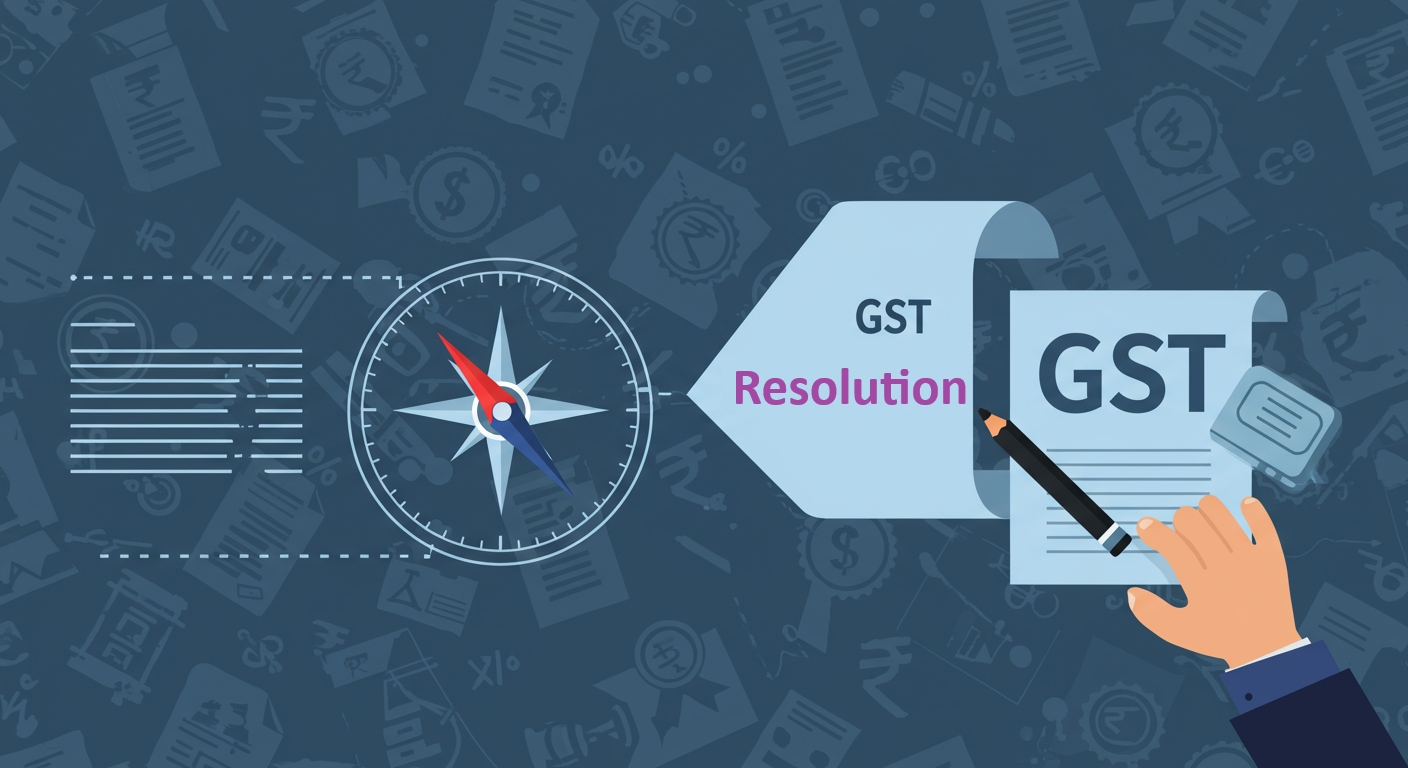The Goods and Services Tax (GST) regime aimed to simplify India’s indirect tax structure, but its implementation has inevitably led to various interpretations and, consequently, disputes between taxpayers and the authorities. For Indian businesses, GST practitioners, and lawyers, understanding these potential conflict points and knowing how to address them is crucial. Effectively Navigating GST Litigation requires awareness, preparedness, and strategic action. This article offers practical guidance on common GST disputes India faces and explores effective ways to resolve GST issues.
Understanding the GST Dispute Landscape
Since its rollout, GST has been a dynamic law with frequent amendments, circulars, and clarifications. This evolving nature, coupled with the complexities of applying the law to diverse business scenarios, often leads to disagreements. Disputes typically arise during assessments, audits, or investigations conducted by the tax authorities.
Common triggers include:
- Differing interpretations of legal provisions (e.g., classification, place of supply).
- Scrutiny leading to alleged discrepancies in returns filed versus underlying data (like GSTR-1 vs. GSTR-3B, or mismatches with GSTR-2A/2B).
- Denial or recovery of Input Tax Credit (ITC).
- Procedural non-compliance identified by tax officers.
Disputes generally progress through a hierarchy: Show Cause Notice (SCN), Adjudication by an officer, Appeal to the First Appellate Authority, Appeal to the GST Appellate Tribunal (GSTAT – gradually becoming functional), and potentially escalating to the High Court and Supreme Court on substantial questions of law.
Common Areas of GST Disputes in India
Understanding where disputes frequently arise helps businesses proactively strengthen their compliance and documentation. Here are some common battlegrounds:
Input Tax Credit (ITC) Mismatches and Eligibility
This remains one of the most significant sources of friction. Disputes often centre on:
- Reconciliation Issues: Differences between ITC claimed in GSTR-3B and the credit reflected in GSTR-2A/GSTR-2B (auto-populated based on supplier filings). Strict conditions under Section 16(2) must be met.
- Supplier Non-Compliance: ITC denial because the supplier hasn’t paid tax or filed returns, even if the recipient holds valid invoices and proof of payment.
- Blocked Credit: Disagreements over ITC claimed on goods or services listed under Section 17(5) (e.g., certain construction services, employee benefits).
- Documentation: Lack of proper tax invoices or debit notes as required by law.
Classification and Rate Disputes
Determining the correct Harmonized System of Nomenclature (HSN) code and applicable GST rate for goods or services can be contentious:
- Ambiguity: Overlapping descriptions or lack of specific entries for novel products/services.
- Composite vs. Mixed Supply: Incorrect determination impacting the applicable tax rate.
- Conflicting Rulings: Divergent views from Advance Ruling Authorities (AAR) or Appellate Authorities (AAAR) across states add to the confusion.
Place of Supply Issues
Determining the correct place of supply is critical for charging the right tax (CGST+SGST or IGST), especially for:
- Services: Complex rules depending on the nature of the service and location of supplier/recipient.
- Intermediary Services: Specific rules often lead to interpretation issues.
- Cross-Border Transactions: Determining export/import status and related compliance.
Valuation Disputes
The value on which GST is levied can be disputed, particularly concerning:
- Related Party Transactions: Ensuring transactions are at arm’s length price.
- Discounts: Treatment of post-supply discounts.
- Free Supplies/Samples: Valuation rules for goods supplied without consideration.
- Inclusion/Exclusion of Costs: Disagreements on whether certain expenses (like freight, insurance) should form part of the taxable value.
Procedural Lapses and Documentation
Simple errors can escalate into disputes:
- Late Filing: Leading to interest and penalties.
- Incorrect Information in Returns: Discrepancies triggering scrutiny.
- E-way Bill Issues: Non-generation, incorrect details, or expiry leading to detention/seizure of goods.
- Inadequate Response to Notices: Failure to respond properly or timely to Show Cause Notices (SCNs).
Strategies to Resolve GST Issues Effectively
When faced with a potential or actual dispute, a structured approach is key.
1. Robust Documentation and Record Keeping
This is the foundation of any defence. Maintain meticulous records, including:
- Tax invoices, debit/credit notes, delivery challans.
- E-way bills.
- Proof of payment to suppliers.
- Reconciliation statements (GSTR-1 vs 3B, 3B vs 2A/2B, Books vs Returns).
- Contracts and agreements supporting transactions.
2. Timely and Accurate Compliance
Proactive compliance significantly reduces the risk of disputes. This includes:
- Filing accurate returns (GSTR-1, GSTR-3B, etc.) within due dates.
- Prompt payment of taxes.
- Regular reconciliations.
- Understanding and implementing changes in GST law. (For more details on proactive measures, see our guide on GST Audits: Procedures, Compliance, and Best Practices).
3. Understand and Respond to the Show Cause Notice (SCN)
An SCN is the starting point of formal adjudication.
- Analyze Carefully: Understand the exact allegations, the legal provisions cited, and the amount demanded.
- Gather Evidence: Collect all supporting documents and information relevant to the issues raised.
- Draft a Comprehensive Reply: Address each point raised in the SCN logically, citing relevant legal provisions, case laws, circulars, and factual evidence. Ensure the reply is submitted within the stipulated time. Missing the deadline can lead to an ex-parte order (an order passed without hearing your side).
4. The Adjudication Process
If the matter proceeds to adjudication:
- Personal Hearing: Always request and attend the personal hearing offered. This is an opportunity to explain your case directly to the Adjudicating Authority.
- Present Your Case Clearly: Structure your arguments logically, supported by documents and legal precedents.
- Written Submissions: File concise written submissions summarizing your arguments and evidence after the hearing.
5. The Appeals Process
If the Adjudication Order is unfavorable, you have the right to appeal:
- First Appellate Authority: An appeal can be filed within three months from the date of communication of the order. A pre-deposit (typically 10% of the disputed tax amount) is usually required.
- GST Appellate Tribunal (GSTAT): The next level of appeal. Functionality is still developing across India. Pre-deposit requirements apply here as well (typically an additional percentage).
- High Court/Supreme Court: Appeals can be filed against GSTAT orders on substantial questions of law.
6. Consider Advance Rulings
For complex transactions where interpretation is unclear, proactively seeking an Advance Ruling can help prevent future disputes on that specific issue. However, be aware that rulings are binding only on the applicant and the specific jurisdictional officer.
7. Engage Professional Help
Navigating GST litigation complexities often requires expert assistance. Consider engaging experienced GST practitioners or lawyers, especially when:
- The stakes (tax amount involved) are high.
- Complex legal interpretations are involved.
- Drafting detailed replies to SCNs or appeal documents.
- Representing the case before adjudicating or appellate authorities.
Proactive Measures for Dispute Prevention
- Internal Reviews: Conduct periodic internal GST health checks or audits.
- Stay Updated: Keep abreast of GST amendments, notifications, circulars, and relevant case laws.
- Vendor Management: Regularly review the compliance status of your key suppliers to mitigate ITC risks.
- Staff Training: Ensure your finance and logistics teams understand GST compliance requirements relevant to their roles.
Conclusion
GST disputes India experiences are a reality for many businesses. While the GST framework aims for simplification, its intricacies mean disagreements are bound to occur. The key to successfully Navigating GST Litigation lies in robust compliance, meticulous record-keeping, understanding the common dispute areas, responding effectively to notices, and utilizing the available redressal mechanisms including appeals. Proactive measures and timely professional guidance can significantly mitigate risks and help resolve GST issues efficiently, allowing businesses to focus on their core operations.
Disclaimer: The information provided in this article is for general informational purposes only and does not constitute professional tax advice. Tax laws are subject to change. Please consult with a qualified tax advisor for advice tailored to your specific situation.
Facing a complex GST notice or potential dispute? Don’t navigate it alone. Consulting with an experienced tax consultant can provide clarity and strategic guidance tailored to your specific circumstances. Reach out to a professional today.



